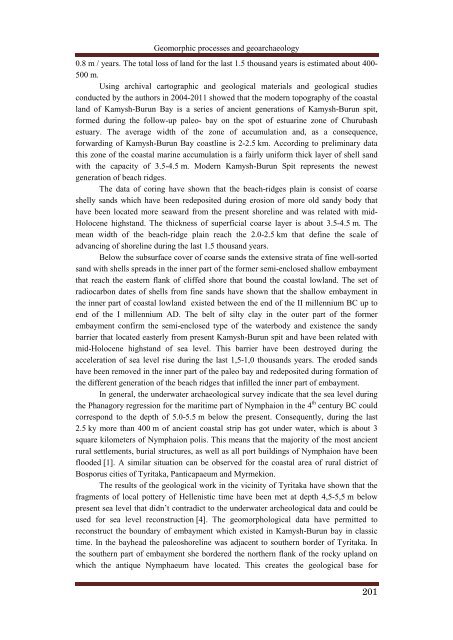extended abstracts - Geomorphic Processes and Geoarchaeology
extended abstracts - Geomorphic Processes and Geoarchaeology
extended abstracts - Geomorphic Processes and Geoarchaeology
Create successful ePaper yourself
Turn your PDF publications into a flip-book with our unique Google optimized e-Paper software.
<strong>Geomorphic</strong> processes <strong>and</strong> geoarchaeology<br />
0.8 m / years. The total loss of l<strong>and</strong> for the last 1.5 thous<strong>and</strong> years is estimated about 400-<br />
500 m.<br />
Using archival cartographic <strong>and</strong> geological materials <strong>and</strong> geological studies<br />
conducted by the authors in 2004-2011 showed that the modern topography of the coastal<br />
l<strong>and</strong> of Kamysh-Burun Bay is a series of ancient generations of Kamysh-Burun spit,<br />
formed during the follow-up paleo- bay on the spot of estuarine zone of Churubash<br />
estuary. The average width of the zone of accumulation <strong>and</strong>, as a consequence,<br />
forwarding of Kamysh-Burun Bay coastline is 2-2.5 km. According to preliminary data<br />
this zone of the coastal marine accumulation is a fairly uniform thick layer of shell s<strong>and</strong><br />
with the capacity of 3.5-4.5 m. Modern Kamysh-Burun Spit represents the newest<br />
generation of beach ridges.<br />
The data of coring have shown that the beach-ridges plain is consist of coarse<br />
shelly s<strong>and</strong>s which have been redeposited during erosion of more old s<strong>and</strong>y body that<br />
have been located more seaward from the present shoreline <strong>and</strong> was related with mid-<br />
Holocene highst<strong>and</strong>. The thickness of superficial coarse layer is about 3.5-4.5 m. The<br />
mean width of the beach-ridge plain reach the 2.0-2.5 km that define the scale of<br />
advancing of shoreline during the last 1.5 thous<strong>and</strong> years.<br />
Below the subsurface cover of coarse s<strong>and</strong>s the extensive strata of fine well-sorted<br />
s<strong>and</strong> with shells spreads in the inner part of the former semi-enclosed shallow embayment<br />
that reach the eastern flank of cliffed shore that bound the coastal lowl<strong>and</strong>. The set of<br />
radiocarbon dates of shells from fine s<strong>and</strong>s have shown that the shallow embayment in<br />
the inner part of coastal lowl<strong>and</strong> existed between the end of the II millennium BC up to<br />
end of the I millennium AD. The belt of silty clay in the outer part of the former<br />
embayment confirm the semi-enclosed type of the waterbody <strong>and</strong> existence the s<strong>and</strong>y<br />
barrier that located easterly from present Kamysh-Burun spit <strong>and</strong> have been related with<br />
mid-Holocene highst<strong>and</strong> of sea level. This barrier have been destroyed during the<br />
acceleration of sea level rise during the last 1,5-1,0 thous<strong>and</strong>s years. The eroded s<strong>and</strong>s<br />
have been removed in the inner part of the paleo bay <strong>and</strong> redeposited during formation of<br />
the different generation of the beach ridges that infilled the inner part of embayment.<br />
In general, the underwater archaeological survey indicate that the sea level during<br />
the Phanagory regression for the maritime part of Nymphaion in the 4 th century BC could<br />
correspond to the depth of 5.0-5.5 m below the present. Consequently, during the last<br />
2.5 ky more than 400 m of ancient coastal strip has got under water, which is about 3<br />
square kilometers of Nymphaion polis. This means that the majority of the most ancient<br />
rural settlements, burial structures, as well as all port buildings of Nymphaion have been<br />
flooded [1]. A similar situation can be observed for the coastal area of rural district of<br />
Bosporus cities of Tyritaka, Panticapaeum <strong>and</strong> Myrmekion.<br />
The results of the geological work in the vicinity of Tyritaka have shown that the<br />
fragments of local pottery of Hellenistic time have been met at depth 4,5-5,5 m below<br />
present sea level that didn’t contradict to the underwater archeological data <strong>and</strong> could be<br />
used for sea level reconstruction [4]. The geomorphological data have permitted to<br />
reconstruct the boundary of embayment which existed in Kamysh-Burun bay in classic<br />
time. In the bayhead the paleoshoreline was adjacent to southern border of Tyritaka. In<br />
the southern part of embayment she bordered the northern flank of the rocky upl<strong>and</strong> on<br />
which the antique Nymphaeum have located. This creates the geological base for<br />
201


